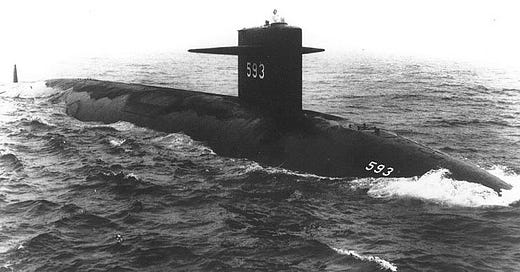TDIH: USS Thresher Sinks
Thresher's crew made the ultimate sacrifice, but they also made the future safer for other submarine crews.
On this day in 1963, the USS Thresher sinks off the coast of Cape Cod. Sadly, a rescue ship was floating helplessly above the wreckage, listening to the sounds of the submarine breaking up below.
The tragedy shocked the naval community. Thresher was considered one of the premier submarines of its time. It was fast—and quiet! It could dive deeper than other submarines. It should have been a valuable asset for the United States during the Cold War.
Instead, it sank and imploded.
Thresher was a relatively new vessel. After its July 1960 launch, it flew through several rounds of sea tests before being returned to a shipyard for an overhaul. A new series of deep dive tests began in April 1963.
On the second day of testing, Thresher’s crew planned to take the sub to her maximum depth of 1,300 feet. Thresher had been to that depth many times before, in the months before her overhaul. The test started off uneventfully for the 129 men aboard the sub, and Thresher was at her maximum test depth by about 9:00 a.m. on April 10.
In the meantime, a submarine rescue ship, the USS Skylark, was floating above Thresher.
Shortly after 9:00, the two vessels checked in with each other. The Skylark’s written log reflects that a “satisfactory” underwater telephone check was made at 9:12. Some officers remembered a straightforward and unalarming report from Thresher: “Have positive up angle. . . . Attempting to blow up.” Some people thought they remembered mention of a “minor problem,” but no one was very worried.
A few minutes later, the Skylark began getting information indicating that something was seriously awry.
Some of the men aboard Skylark thought that they heard sounds coming up from below—the sounds of air under high pressure. At 9:14, the Skylark messaged that the surface was clear for Thresher to come back up, and it asked Thresher to make contact.
But there was no response from the submarine’s crew.
At 9:17, an unintelligible message was received. Mere seconds later, a terrible sound could be heard. One officer later testified: “We heard sounds that are familiar to me, from having seen ships blown up by torpedoes in World War II—the sound of a ship breaking up—like a compartment collapsing.”
Those listening on sonar said they heard the sound of “air rushing into an air tank.”
Skylark patrolled the area and repeatedly called out to Thresher, but it was too late. The submarine was gone.
A subsequent investigation into the matter determined that the saltwater piping system had broken apart, submerging the sub’s electric system and disabling the nuclear reactor. The sub could not be controlled and, sinking past its maximum depth, it imploded.
The tragedy prompted new standards and designs for submarine piping systems. The Navy also implemented a new set of safety standards and testing, called SUBSAFE. Since implementation of the SUBSAFE program, no submarine has been lost in a non-combat situation such as the one that took Thresher and her crew.
Those aboard Thresher made the ultimate sacrifice. They also made the future safer for other submarine crews.
Sources can always be found on my website, here.





Thank you Tara for posting the story of the Thresher. This was a piece of history that really got my attention as a kid and prompted a fascination with submarines that has stayed with me to this day. I took a group of 30 Boy Scouts and adults to Kings Bay, GA, 20 years ago to tour the Maryland, while in port for maintenance. Over 100 officers, sailors, and civilians were lost that day on Thresher. Thank you today specifically to submariners everywhere for the silent job you do keeping’s us safe, and to you, Tara, for remembering them.
What a terrible tragedy for the men aboard the Thresher, but also for the helpless men aboard Skylark. How awful to hear those sounds and know what they meant for everyone on that submarine. All those men on the Thresher are heroes. Many brave acts have been done by our military in noncombat situations. We just don’t hear about them. Thanks for the refresher course, Tara.